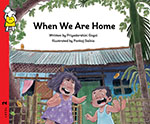Every year the State of Assam loses large tracts of land to yearly floods and land erosion. Lakhs are displaced and loss of property is on a large scale. Many have witnessed the vanishing of their home and hearth in the middle of the mighty Brahmaputra. Many are forced to live in relief camps while others are compelled to search for newer habitats. This mobile impermanent life is a lived reality for thousands of families in Assam.
Pratham books are known for bringing stories for children rooted in the lives of people across the nation and this book is no different. Priyadarshini Gogoi’s book When We are Home brings such a story. Beautifully illustrated by Pankaj Saikia, it gives voice to the experience of a large number of families in Assam. This is the story of Huntu and his family. Through vivid and colourful pictures and simple narratives, their experience is presented from the point of view of these two children. Every page of the book gives an account of how home feels to the little ones. Every page also carries a picture of the children sailing on a makeshift boat made of banana tree trunks.
The book uses ample objects from everyday lives of a rural household in Assam. From food to items in the house, we get a glimpse of a rural household. These are also the people living in temporary villages near rivers or chaporis. And they are the most vulnerable section during floods. The displacement deprives people and especially children of the familiarity and security of home—the place which to them comes in the forms of the til pithas (homemade cookies made from sesame seeds’ paste) made by grandma or the snores of a hardworking father taking an afternoon nap, the smell of orchids or the playful goats.
Where father sleeps, there is a makeshift study table and a cut out of the popular Assamese Magazine Prantik with a photo of Dr Bhupen Hazarika. There is a laminated certificate from the Axom Xahitya Xabha which is the primary institution working for the development of Assamese language and literature. The presence of a handloom where the mother sits and works, a portrait of Jyotiprasad Aggarwala and a copy of Hemkosh also reflects the various aspects of the lives of an Assamese family.
As floods devastate homes and lives of people in Assam, they long for a return to this familiar set up. Relief camps and make-shift tents are no replacement to this. The nostalgia that even children feel towards their home is portrayed beautifully through this book. In a simple and easy to grasp way, the author relayed perhaps the biggest problem of the people of Assam—yearly floods and displacement.
The book will familiarize people not only with the problem of flood but also the socio-cultural lives of the people of Assam. However, the rural lives of people in Assam have undergone much change. This pristine portrayal of a thatched hut and a simple life is a caricature of a past frozen in time which comes back to us in the form of powerful nostalgia. Displacement, erosion is no more a simple problem with similar experience across the communities. Displaced people have been either rehabilitated in some other places or many have squatted on government land. Recent cases of eviction show that the evictees were mostly people displaced by floods. The experience of people also varies depending on their location. Areas in lower Assam, especially border districts like Dhubri, have not only seen the highest loss of land but also raised questions of identity and citizenship of these displaced people. Priyadarshini Gogoi’s book while presenting a simplified linear version of floods and displacement in Assam does put forth a humanitarian crisis which is often overlooked as a problem of a distant border State. This book will appeal to universal human emotions of loss and longing for one’s own home.
November 2023, volume 47, No 11

